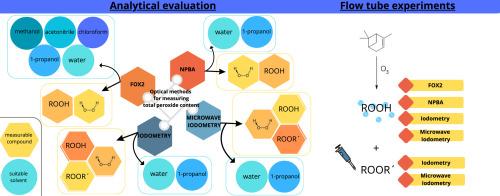Analytical optical methods for measuring organic peroxides and hydroperoxides: An evaluation
IF 4.2
2区 环境科学与生态学
Q2 ENVIRONMENTAL SCIENCES
引用次数: 0
Abstract
Hydrogen peroxide, organic peroxides and hydroperoxides exhibit high reactivity and play a pivotal role in atmospheric chemistry. These compounds are formed during the oxidation of volatile organic compounds in both gaseous and aqueous phases, particularly under low NOx conditions. Their significant contribution to the mass of secondary organic aerosols (SOA) is well-documented, and they are believed to have significant health implications. Several spectrophotometric methods have been employed to measure SOA-bound peroxides in laboratory samples, but systematic comparisons are lacking. In this study, we have assessed the advantages and limitations of these methods, including the traditional and microwave-assisted iodometric methods, the 4-nitrophenyl boronic acid assay (NPBA), and the Fenton reaction-assisted ferrous-xylenol (FOX2) assay. Besides, a comprehensive evaluation of these methodologies was conducted for the first time across a substantial cohort of commercial peroxides and hydroperoxides, employing diverse solvents (namely, water, 1-propanol, acetonitrile, methanol and chloroform) to provide broader insights compared to previous work. Ultimately, the four methods were applied and compared for peroxide determination in laboratory-generated SOA resulting from gas-phase ozonolysis of α-pinene. This study opens new opportunities for future mechanistic investigation into SOA formation and reactivity.

测量有机过氧化物和氢过氧化物的分析光学方法:评估
过氧化氢、有机过氧化物和氢过氧化物具有很高的反应活性,在大气化学中起着举足轻重的作用。这些化合物是在气相和水相挥发性有机化合物氧化过程中形成的,尤其是在低氮氧化物条件下。它们对二次有机气溶胶(SOA)质量的重大影响已得到充分证实,而且人们认为它们对健康有重大影响。已有多种分光光度法用于测量实验室样本中与 SOA 结合的过氧化物,但缺乏系统的比较。在本研究中,我们评估了这些方法的优点和局限性,包括传统碘量法和微波辅助碘量法、4-硝基苯硼酸测定法(NPBA)和芬顿反应辅助亚铁-二甲酚(FOX2)测定法。此外,还首次在大量商用过氧化物和氢过氧化物中对这些方法进行了全面评估,并采用了不同的溶剂(即水、1-丙醇、乙腈、甲醇和氯仿),以提供比以往工作更广泛的见解。最终,这四种方法被用于测定实验室产生的 SOA 中的α-蒎烯气相臭氧分解产生的过氧化物,并进行了比较。这项研究为今后从机理角度研究 SOA 的形成和反应性提供了新的机会。
本文章由计算机程序翻译,如有差异,请以英文原文为准。
求助全文
约1分钟内获得全文
求助全文
来源期刊

Atmospheric Environment
环境科学-环境科学
CiteScore
9.40
自引率
8.00%
发文量
458
审稿时长
53 days
期刊介绍:
Atmospheric Environment has an open access mirror journal Atmospheric Environment: X, sharing the same aims and scope, editorial team, submission system and rigorous peer review.
Atmospheric Environment is the international journal for scientists in different disciplines related to atmospheric composition and its impacts. The journal publishes scientific articles with atmospheric relevance of emissions and depositions of gaseous and particulate compounds, chemical processes and physical effects in the atmosphere, as well as impacts of the changing atmospheric composition on human health, air quality, climate change, and ecosystems.
 求助内容:
求助内容: 应助结果提醒方式:
应助结果提醒方式:


